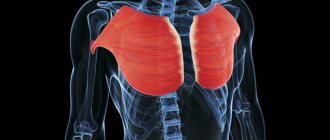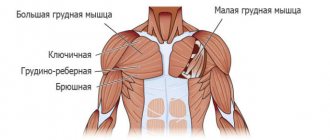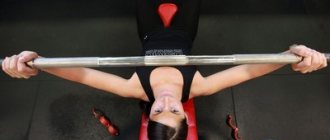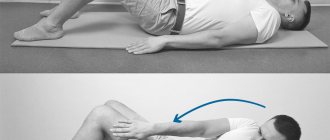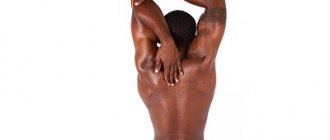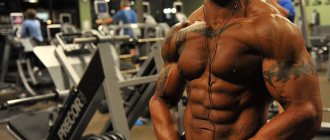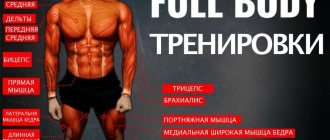Content
- 1 Pectoral muscles - exercises and training features 1.1 Anatomy
- 1.2 Features of chest training
- 2.1 Exercises for the upper chest
- 7.1 Basic chest exercises
Isolation exercises
The inclusion of such exercises in a training complex is recommended for experienced athletes. For athletes with no more than 2 years of experience, doing a base on the chest will be enough.
Isolation exercises allow you to refine your muscle shape, that is, make it more prominent and expressive. They are performed at the end of strength training after a base with maximum weight. Consider the following few exercises with dumbbells to pump up your chest.
Dumbbell flyes
This exercise with dumbbells is the leader among isolated exercises. When performing it, one shoulder joint works, that is, the main effort is concentrated on the pectoral muscles.
Starting position:
- On the bench, take a sitting position with your knees bent.
- Place dumbbells on your knees in a vertical position.
- Take a lying position.
- Raise your arms with your elbows slightly bent so that the dumbbells are above your shoulders.
Technique:
- On a deep inhalation, arms are spread to the sides to the peak points. Then they are fixed in this position. At the same time, a pleasant feeling of stretching should appear in the chest muscles, but not without pain.
- As you exhale smoothly, your arms are slowly brought together without jerking until the dumbbells touch. Pause.
It is recommended to ensure that during the exercise you do not allow your arms to fully straighten to avoid injury to the elbow joint. It is also necessary to keep your back straight, since when you bend, part of the load is transferred from the chest to the lower back. As for the weight of dumbbells, it should be moderate.
Pullovers
Since using heavy weights and stimulating muscle fiber is very difficult in this exercise, it cannot be called the best exercise for the chest. But it contributes to the process of chest expansion, so it must be included in the training program of young athletes.
Starting position:
- Take dumbbells and place them with their ends on the floor near the bench.
- Take a lying position - only the upper back is on the bench.
- Bend your lower back and grab the dumbbell with both hands (by the upper part). You can ask someone to hand you dumbbells.
- Raise the barbell above your chest with your arms almost fully extended.
Technique:
- The dumbbell is lowered behind your head as you inhale, while your elbows should remain slightly bent.
- Following a similar trajectory, when you exhale, the dumbbell rises to its starting position.
This exercise must be performed smoothly, without haste or sudden movements. At the upper limit, the arms should not be fully straightened to avoid injury to the elbow joint. At the lower limit, you should lower the dumbbells as low as possible, stretching the chest muscles.
Let's look at isolation exercises for the chest using machines.
Butterfly trainer: hand pinch
Despite the many varieties of this simulator, they are all based on the same operating principle. To practice on it, no special training is required, and the likelihood of injury is practically reduced to zero. Perhaps this explains the popularity of this simulator among beginners who are not yet ready to work with a barbell.
Starting position:
- On the machine bench, take a sitting position with your back straight and tightly pressed to it.
- Your feet should be comfortably spaced shoulder-width apart.
- Wrap your hands around the handles, rest your forearms on the pillows.
Technique:
- Take a deep breath, then with a powerful movement as you exhale, bring your hands together until they touch.
- As you inhale, smoothly return your hands to the starting position.
During arm raises, it is recommended to try not to reduce the load on the pectoral muscles. It is also important to keep your back pressed against the bench (do not lift it).
Pectoral muscles - exercises and training features[edit | edit code]
Yuzhakov Anton HOW TO PUMP YOUR CHESTS THE BEST CHEST MUSCLE EXERCISES FOR BEGINNERS
The best exercises for chest
Pectoralis major muscle (highlighted in color)
SETH FEROSI. The coolest chest workout (GymFit INFO)
Powerful breasts are a symbol of courage and heroism, so in bodybuilding the pectoral muscles are given special importance. Dorian Yates believes that the hallmark of bodybuilding is not biceps, as many beginners tend to believe, but powerful chest. Due to the large volume of muscles, chest training requires a large expenditure of calories, so it is also useful for burning excess fat, which must be taken into account when choosing a diet.
Anatomy[edit | edit code]
Read the main article:
Anatomy and functions of the pectoral muscles
The chest consists of the pectoralis major and minor muscles. Pectoralis major muscle
(pectoralis major) is the largest muscle of the chest; it originates over a long distance from the collarbone to the sternum, attaching to the humerus.
The main function of the muscle is flexion and adduction of the shoulder, as well as its internal rotation. The pectoralis minor muscle
is a small, triangular-shaped muscle located under the pectoralis major, and generally duplicates its functions.
Features of chest training[edit | edit code]
Chest muscles
There is a lot of conflicting information regarding proper training of the pectoral muscles, but science and sports medicine do not stand still, and there is now reliable data on proper chest training. To stimulate the pectoral muscles to grow, you do not need to pump them up every workout and perform countless repetitions and approaches. If you systematically overload your pectoral muscles, don't be surprised why you haven't achieved good results yet. To prevent this, below are recommendations for effective training of the pectoral muscles:
- Chest training is closely related to triceps, so when planning your training program, do not train chest and triceps on the same day. By doing triceps and chest workouts on different days, you have the advantage that on triceps day you will hit your chest, but much less than on chest day, and the same goes for triceps. Thus, the load on the triceps and chest will vary from light to heavy, this will prevent the muscles from adapting to the load, creating supercompensation of different parameters, and accordingly will have a much better effect on muscle growth. Read more:
Muscle adaptation to stress - Chest training should be done no more than twice a week for beginners (minimum rest period 2 days). Read more:
Optimal training frequency - Perform 4-8 approaches to the chest (the sum of the approaches of all exercises). So, for beginners, one or two exercises of three or two approaches, respectively, are enough. The optimal number of repetitions for the chest in order to increase mass is 10-12 times. To increase strength, repeat 6-8 times.
Complex No. 1
Aimed at activating the mobility of the thoracic spine and chest and ensuring deep breathing.
1. Starting position - sitting on a chair with a back, arms down along the body.
- while inhaling, place your hands on the back of your head and bend back, pressing against the upper edge of the back
- while exhaling, return to the starting position
- repeat 3-4 times
2. Starting position - sitting on the edge of a chair, leaning the upper part of the thoracic spine on the upper edge of the back of the chair (light version).
- while inhaling, place your hands on the back of your head and bend back, pressing against the upper edge of the back
- while exhaling, return to the starting position
- repeat 3-4 times
3. Starting position - lying on your back on a flat and hard surface, hands behind your head.
- A hard cushion with a diameter of 10 cm is placed under the back in the area of the thoracic spine.
- bend over while inhaling
- As you exhale, lift your upper body. Moving the roller along the spine,
- repeat the exercise 3-4 times
4. Starting position - lying or sitting.
- wrap your chest in a towel, grab its ends with your hands, slightly stretching them in opposite directions.
- take a deep breath, stretch the ends of the towel tightly, squeezing your chest as much as possible, and exhale
- take a deep breath again, loosening the tension of the towel
- repeat 6-10 times.
5. Starting position - sitting or standing, placing your feet at the width of your feet.
- while inhaling, raise your arms above your head, grab your right wrist with your left hand, bend as far as possible to the left, stretching your right arm
- in this case, on the right there should be a feeling of stiffness in the lateral muscles of the chest
- while inhaling, return to the starting position
- do the same in the other direction
- repeat 6-10 times.
Selective chest training[edit | edit code]
Main areas of influence of various exercises
To summarize, I would like to draw attention to the fact that all exercises involve the pectoral muscle almost completely, however, almost every exercise has its own emphasis on a specific area. Below are exercises for training individual chest areas.
Upper chest exercises[edit | edit code]
- Bench press with the head end of the bench raised
- Dumbbell flyes with the head end of the bench raised
- Head down push-ups
- Army press
- Lifting a barbell or dumbbells in front of you
- Bench press with the head end of the bench raised
- Dumbbell flyes with the head end of the bench raised
- Head down push-ups
- Army press
- Lifting a barbell or dumbbells in front of you
Exercises for the lower chest[edit | edit code]
- Bench press with the head end of the bench down
- Pullovers
- Pushups
- Dips
- Dumbbell flyes with the head end of the bench lowered
- Bench press with the head end of the bench down
- Pullovers
- Pushups
- Dips
- Dumbbell flyes with the head end of the bench lowered
Top 4 basic exercises for the pectoral muscles
The number of basic exercises for a muscle group is quite large, but in most cases all movements are of the press type. They are used not only to train the pectoral muscles for mass, but also to develop the entire shoulder girdle.
Bench press
This is a classic basic chest exercise for men. It is used in all types of strength sports and is the main competitive movement in several disciplines. It has many variations that are used to comprehensively work out each area of the chest:
- The barbell bench press is a classic option.
- With an inclination - to work the upper chest.
- With a downward tilt - to shift the load to the lower chest.
- In Smith - to stabilize the position of the barbell and increase working weights.
All these exercises for the mass of the pectoral muscles should be included in the training program, alternating between days.
Dumbbell Bench Press
Despite the fact that when using dumbbells, additional muscles are included in the work (to stabilize the position of the arms), performing presses with dumbbells more specifically works the chest area. This is due to the fact that you can increase the amplitude and use the most convenient trajectory of movements, taking into account physiological characteristics.
Technique:
- Sit on the edge of a bench, placing the dumbbells on your thighs. Lie down on a bench while simultaneously pushing the weights out with your thighs. In the lower position, the dumbbells should be held with a straight grip (palms facing the legs), simulating holding a barbell.
- Start lowering the dumbbells as low as possible.
- Take a minimal pause and return your hands to the starting position.
At the top point, it is necessary to avoid contact between the dumbbells (including the beating), and also to maintain a slight bend in the elbow. The main difference when working with dumbbells is that as you lower the dumbbells, your arms move to the sides, creating an additional stretch.
Dips
A very underrated movement. Despite its high effectiveness, push-ups are rarely added to mass pectoral programs. The movement is performed not only in the gym, but also on sports fields, as well as at home (if you have a simulator).
Technique:
- Step onto the bars and lean your body slightly forward (your legs can be bent or pulled back to maintain balance).
- Begin to slowly lower your body down (elbows point back and slightly to the sides, depending on the width of the bars).
- Quickly push your body to the starting position without straightening your elbows completely at the top point.
It is important to maintain the angle of inclination of the body (in a completely vertical position, the load goes to the triceps). It is a mistake to progress in push-ups by trying to perform more reps per set. This option will only worsen the development of muscle mass. Try to perform 7-10 repetitions with strict adherence to technique, using additional weights for development (vests, chains, plates).
Read more about dips →
Pushups
Although working with your own body weight is unpopular in the gym, calisthenics can provide excellent muscle growth. Push-ups are one of the most versatile and effective basic exercises for the chest muscles. It can be performed anywhere, from the gym to home, providing excellent development not only of the chest group, but also of the entire upper body.
The huge benefits of push-ups are:
- Adaptation of the load to any level of physical fitness.
- A large number of variations to shift the load and comprehensively pump the group.
- Additional development of the core muscles.
As with parallel bars, it is important to progress with push-ups without going beyond the 8-12 rep range. For this, any weights are used, from pancakes to weights.
Exercises for the inner and outer chest[edit | edit code]
Based on the rules of elementary biomechanics, it follows that it is possible to pump up a separate part of a specific muscle only if this part performs a separate motor function, for example, the deltoid muscle bundles.
However, it is impossible to pump the external and internal parts of the pectoral muscles separately.
, since the load will be uniform over the entire horizontal plane of the pectoral muscles. Thus, separate pumping of the internal and external areas is nothing more than a myth and a common misconception.
Weight-bearing exercises[edit | edit code]
- Bench press with the head end of the bench raised
- Dumbbell flyes with the head end of the bench raised
- Army press
- Lifting a barbell or dumbbells in front of you
- Bench press with the head end of the bench down
- Pullovers
- Dumbbell flyes with the head end of the bench lowered
- Dumbbell flyes on a horizontal bench
- Bench press on a horizontal bench
- Dumbbell flyes on a horizontal bench
- Bench press with the head end of the bench raised
- Dumbbell flyes with the head end of the bench raised
- Dumbbell flyes lying on the floor
- Army press
- Lifting a barbell or dumbbells in front of you
- Bench press with the head end of the bench down
- Pullovers
- Dumbbell flyes with the head end of the bench lowered
- Dumbbell flyes on a horizontal bench
- Bench press on a horizontal bench
- Dumbbell raises
- Dumbbell push-ups
The best exercises for chest training[edit | edit code]
Chest workout
Basic chest exercises
Yuzhakov Anton Training program for pectoral muscles
Basic chest exercises[edit | edit code]
Features of strength training for the pectoral muscles
- Bench press
A basic exercise that involves working several large muscle groups, including the pectorals. Recently, articles have increasingly suggested that the bench press is ineffective for chest development. A major role was played by Dorian Yates's popular article on breast development, where he speaks negatively about the bench press, however, the author himself notes that his opinion is based on personal experience and cannot be extrapolated to everyone. Those who defame the lack of effectiveness of the bench press are fundamentally wrong. This exercise has been and remains one of the best for chest training, and it is especially suitable for beginners. Professionals can also successfully use the bench press in their training. To shift the load on the pectoral muscles, take the bar with a wide grip.
Another advantage of this exercise is the ability to change the main area of influence. To do this, perform the bench press on an incline bench. Raising the head end pumps the top of the chest more, lowering the head end pumps the bottom of the chest. Adjust the inclination of the bench depending on which part of the pectoral muscles you need to use more.
- Dips
A simple exercise for the lower and outer pecs and triceps. Athletic bars can be found not only in the gym, but also in the courtyard of the house, at school stadiums, parks and other public places, however, it should be noted that for chest training, wide bars (70 - 80 cm) are required; a narrower space will displace the strength emphasis on triceps.
- Pushups
Push-ups from the floor do not differ in the type of impact on muscles from the bench press; you can also adjust the level of inclination of the body and shift the emphasis of the load to the upper or lower part of the pectoral muscles. Push-ups are a good chest workout and don't require any equipment or a gym. You can use a backpack with a load or the help of a partner as a burden.
Isolation exercises for the chest[edit | edit code]
- Dumbbell raises
This isolated exercise uses the pectoral muscles, mainly the inner and upper parts. The exercise should be performed slowly, completely eliminating cheating. This is one of the best exercises for training your chest.
- Crossovers
Crossovers are also known as crossovers. This is a specialized exercise for pumping the inner and lower parts of the chest. There are crossover machines in almost all modern gyms.
For many athletes, crossover work is more effective than dumbbell flyes because it provides more tension in the contracted position. Compared to presses, it gives a greater stretch and also increases the range of motion. However, many athletes are able to build their chest faster with bench presses and push-ups than with crossovers. This is usually due to the fact that they have quite high neuromuscular efficiency in the pectoral muscles. So, if your pecs don't respond well to bench presses and other exercises, crossover pecs are ideal for you.
- Straight arm pullovers
This is an optimal exercise for expanding the chest, and works the pecs (especially the lower part), serratus anterior, and lower latissimus dorsi.
- Army press
The military press, also known as the standing press, is a basic exercise for training the muscles of the shoulder girdle (especially the upper pectoral muscles) and triceps. Recently, the military bench press has lost popularity due to the advent of multifunctional exercise machines. When performing a military press, both a barbell and dumbbells can be used.
Mistakes when performing chest exercises
This type of exercise is very often performed by athletes; performing it correctly allows you to quickly achieve the desired result. However, among gym goers you can often find the following common mistakes:
- Weight abuse. It is known that the use of heavy weights has a beneficial effect on the development of chest muscles. However, you need to remember that when working with significant weights, a considerable share of the load goes to the triceps and deltoids. Therefore, in order to achieve the maximum effect specifically for the chest area, it is recommended to slightly reduce the weight, but pay more attention to the technique of performing the exercise.
- Chop. It makes lifting weights easier and allows you to do more repetitions. But the impulsiveness leads to less stress on the chest, and increases the likelihood of injury.
- Split exercises with back or legs. If you need to acquire basic indicators, the press-dead-squat triple will be quite justified. This complex is also suitable for powerlifters. But if the athlete’s task is to work out the chest, it is better to refuse it. The accumulation of fatigue during deadlifts and squats will not allow you to fully load the pectoral muscles and get the desired result. If you want to combine exercises, then working out the triceps or biceps is better suited for this.
- Limit to bench press. This exercise can serve as a basic exercise for the pectoral muscles. But efficiency can be increased by adding wiring. You should also practice incline presses.
- Neglect of exercise equipment. Many athletes rarely resort to using exercise machines, considering them insufficiently effective due to their fixed amplitude. However, this opinion is wrong. Exercise machines allow you to concentrate on a specific muscle group and work out lagging muscle groups. They will be most effective when used correctly after the main press, but before flyes.
Article from Muscle & Fitness 2012 No. 1[edit | edit code]
If the pectoral muscles can surprise you with anything, it is their gigantic size. The goal of gaining maximum muscle volume is rightfully considered the main one here, and therefore should be at the very center of your training strategy. The key to huge pecs is strict adherence to the classic rep range (8-12 reps per set). Low-rep powerlifting-style sets won't help much here. And don't let the veterans' extreme weights fool you. Many of them just amuse their vanity with records. Remember, any set you perform must fit into a proven repetition scheme.
TO GROUNDS
- Bench press 5x8
- Dumbbell Incline Press 3x12
- Barbell head down press 3x12
- Crossovers on 5x10 blocks
NEWBY
- Push-ups 3x10
- Dumbbell bench press 3x10
- Dips 3x10
- Details of dumbbells lying 3x10
TRAINING AT HOME
- Push-ups on the floor 3x20
- Dumbbell floor press 3x12
- Details of dumbbells on a 3x12 ball
ONLY 15 MINUTES!
- Dumbbell bench press 3x10
- Push-ups (legs on support) 3x15
- Hand raises in the 3x20 simulator
FOCUS ON BOTTOM BREASTS
- Barbell head down press 3x12
- Dumbbell head down press 3x12
- Dumbbell head down curl 3x15
- Dips 3x to failure
EMPHASIS ON THE UPPER CHESTS
- Incline bench press 3x12
- Dumbbell Incline Press 3x12
- Oblique hand raises on 3x15 blocks
- Push-ups (feet on support) 3x12
FORCE!
- Bench press 5x5
- Dumbbell floor press 3x6
- Push-ups on the floor with cotton 5x5
- Dips with weight 3x to failure
CIRCULAR TRAINING
- Bench press 4x10
- Push-ups on the floor 4x10
- Dips 4x10
- Alternating dumbbell press on a 4x10 ball per arm
Basic chest exercises: technique and tips
Only if you follow the rules for performing the exercise can you achieve truly tangible results. The advice given for each element of the training will also help in this matter.
Barbell bench press
Suitable for beginners. This is the basis and in its principle the exercise is one of the variants of push-ups from the floor. When the incline of the bench changes, the impact zones shift and this is one of the main advantages of the bench press. In a positive tilt the upper chest works, in a head down position the lower chest works. For the pectoral muscles, this is an ideal training for strengthening and building mass. The number of approaches depends on the training program, but usually there are 3-4 with repetitions 6-12 times.
Starting position:
- On the bench, take a lying position, with your buttocks, shoulders and head pressed against its surface. The back is slightly arched in the lower back, the legs are shoulder-width apart with the feet resting on the surface of the floor.
- The barbell is taken with a wide grip and removed from the thrust mechanisms, then raised parallel to the middle of the chest to the peak level. If necessary, you can resort to the help of a partner.
Technique:
- On a deep breath, the projectile drops to the lower limit (it should lightly touch the body). Breathing is fixed.
- The bar is pressed up to the starting position with a powerful exhalation towards the end. At the peak there is a short pause, the pectoral muscles tense to the limit.
You need to lower the barbell without jerking, the movement should be smooth and unhurried. But it should be lifted with a moderately quick movement, while it is important not to allow the back to bend, and the projectile should not be springy from the body.
Dips
When it comes to working out the muscles of this group, this exercise is one of the most important. In fact, this is one of the options for bench press in a prone position, with one difference - the naturalness of the movement. During the training process, almost all muscle groups are involved, including the arms, shoulder girdle, back, abdominal and stabilization muscles.
It is important that the bars are spaced at a distance slightly greater than shoulder width. If it is too wide, the risk of injury to the shoulder area increases, and if it is narrower, the main load falls on the triceps, so it is suitable for working the latter.
Starting position:
- Emphasis on the uneven bars with straight arms.
- You should start from this position, as it promotes muscle contraction and allows you to prepare them for the subsequent load.
Technique:
- The body leans forward, then, as you exhale, smoothly lowers down with your arms bent at the elbows.
- Pause and then slowly rise up without jerking, gradually straightening your arms. Exhalation.
It is very important to lower yourself slowly and smoothly to avoid injury to the chest or elbow muscles. The position of the elbows is turned to the sides. When lifting, try to avoid getting them close to your ribs. In order for all the chest muscles to be involved, you need to lower deeply until your hands are parallel to the lower chest. If there is insufficient downward movement, all the work falls mainly on the triceps.
As for weights, its use is inappropriate until the maximum amplitude when doing push-ups on the uneven bars has been achieved. By the number of repetitions - as many as you can.
